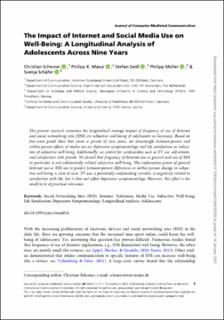| dc.contributor.author | Schemer, Christian | |
| dc.contributor.author | Masur, Philipp | |
| dc.contributor.author | Geiss, Stefan | |
| dc.contributor.author | Müller, Philipp | |
| dc.contributor.author | Schäfer, Svenja | |
| dc.date.accessioned | 2021-02-09T09:12:59Z | |
| dc.date.available | 2021-02-09T09:12:59Z | |
| dc.date.created | 2020-09-30T13:47:57Z | |
| dc.date.issued | 2020 | |
| dc.identifier.issn | 1083-6101 | |
| dc.identifier.uri | https://hdl.handle.net/11250/2726787 | |
| dc.description.abstract | The present research examines the longitudinal average impact of frequency of use of Internet and social networking sites (SNS) on subjective well-being of adolescents in Germany. Based on five-wave panel data that cover a period of nine years, we disentangle between-person and within-person effects of media use on depressive symptomatology and life satisfaction as indicators of subjective well-being. Additionally, we control for confounders such as TV use, self-esteem, and satisfaction with friends. We found that frequency of Internet use in general and use of SNS in particular is not substantially related subjective well-being. The explanatory power of general Internet use or SNS use to predict between-person differences or within-person change in subjective well-being is close to zero. TV use, a potentially confounding variable, is negatively related to satisfaction with life, but it does not affect depressive symptomatology. However, this effect is too small to be of practical relevance. | en_US |
| dc.language.iso | eng | en_US |
| dc.publisher | Oxford University Press (OUP) | en_US |
| dc.rights | Navngivelse 4.0 Internasjonal | * |
| dc.rights.uri | http://creativecommons.org/licenses/by/4.0/deed.no | * |
| dc.title | The Impact of Internet and Social Media Use on Well-Being: A Longitudinal Analysis of Adolescents Across Nine Years | en_US |
| dc.type | Peer reviewed | en_US |
| dc.type | Journal article | en_US |
| dc.description.version | publishedVersion | en_US |
| dc.source.journal | Journal of Computer-Mediated Communication | en_US |
| dc.identifier.doi | https://doi.org/10.1093/jcmc/zmaa014 | |
| dc.identifier.cristin | 1835638 | |
| dc.description.localcode | © The Author(s) 2020. Published by Oxford University Press on behalf of International Communication Association. All rights reserved. For permissions, please email: journals.permissions@oup.com This is an Open Access article distributed under the terms of the Creative Commons Attribution License (http://creativecommons.org/licenses/ by/4.0/), which permits unrestricted reuse, distribution, and reproduction in any medium, provided the original work is properly cited. | en_US |
| cristin.ispublished | false | |
| cristin.fulltext | original | |
| cristin.qualitycode | 2 | |

